Vul. Teatralna, 13 – St. Peter and Paul Church (former Jesuit Church)
The Jesuit church is located in the historic center of Lviv, near the former western side of the town fortifications. This is one of the biggest churches of the city, an example of a baroque and Renaissance basilica built upon the pattern of the Il Gesù church in Rome by well-known architects, sculptors, carvers and painters. According to the resolution of the Council of Ministers of the Ukrainian SSR number 970 dated 23 August 1963, the Jesuit church was entered in the National list of monuments under protection number 338.
Architecture
The church of SS. Peter and Paul is one of the biggest sacral buildings in the city: it is 41 meters long, 22.5 meters wide, and 26 meters tall. Considering its planning and spatial structure, it is a three-nave basilica with a small manysided altar and a narthex. It is constructed in the early Baroque style with some Renaissance reminiscences. The main façade composition is patterned upon the Il Gesù church in Rome. The façade has two levels, it is divided horizontally into two parts by a developed entablement and accentuated with a big pediment which has Baroque volutes on the sides and a triangular crowning; it is also decorated with pinnacles on both sides. The pilasters and the composite order capitals divide the façade vertically into five fields. Each of the three naves of the church has a separate entrance from the main façade; the main entrance, which is decorated with a white stone portal in the form of a portico with a balcony over it, is located on the central axis; identical but smaller portals with balconies over them decorate side entrances. Sculpture figures of Jesuit saints are placed symmetrically in narrow fields between pilasters, in eight conch niches.
The southern façade is notable for its massive flying buttresses which convey the thrust of the main nave vaults to the outwalls and lean on platforms crowned with pinnacles having crosses on them. In the walls between the flying buttresses big thermal windows are made which light up the main nave. The south-western corner over the crowning cornice fixes a tier of the tower. The tower is laid of brick on the level of the cellars, the foundation and the cellars themselves being built of stone; it is square in plan and has wooden stairs in the lower part; the upper tiers can be accessed via ladders. The wall of the fourth tier is cut through with four rectangular window openings. The tower is covered with a low pyramidal roof. One can enter the tiers due to a system of ladders.
The church is covered with a double-pitch red tile roof with small simplified lucarnes made during the 1959 reconstruction of the roof; it is crowned with a flèche over the triumphal arch.
The main façade architecture takes its shape due to sculptures and white stone décor of the seventeenth and nineteenth centuries: window framings, some Manneristic décor (binding and plant ornaments, zoo- and anthropomorphic motifs). The southern window is notable for its special decorations as among the volutes and flower petals profiles of a jester, a lamb, a parrot and some others can be distinguished. The sculpture decorations of the upper tier consists of figures of the Mother of God, martyr Marcin Laterna, St. Stanislaus the Bishop, Pope Paul III. The upper figures are dynamic while the lower ones are static. A medallion with a relief image of the New Testament Lamb is placed in the crowning pediment tympanum.
Figures of Jesuit fathers, those of SS. Francis Xavier, Ignatius of Loyola, Andrew Bobola, and Stanislaus Kostka, are placed in the lower tier; they are made of sandstone in the academic style by sculptor Feliks Pawliński of Leopold Schimser’s stonemasonry company in 1894.
In the interior, the main nave is covered with a semicircular lunette vault accentuated with a massive entablement which leans on pilasters having composite wooden capitals. The side naves, in comparison with the central one, are very narrow and low; emporia galleries are situated over them, and a choir loft with an organ is located over the narthex. The side naves and the emporia are bridged with cross (smooth) vaults leaning on pointed arch walls. All the walls and vaults surfaces are covered with paintings.
The monumental, three-tier main altar is made of pink and black marble and separated by a marble balustrade; it is decorated with sculptures of saints and angels.
The floor is paved with black and pink marble slabs.
The cellars are laid of stone and bridged with a system of semicircular vaults made of brick. The crypts, where Jesuit monks were buried, are made under the main and northern naves; one can enter the crypts from the main nave. The cellar under the southern nave is bridged with cross and sail vaults; it can be entered from the west (under the tower). The cross vault in the south-eastern corner of the cellar leans on carved Renaissance toes. The cellar windows under the southern nave are rectangular, they are situated in deep semicircular niches and are of defensive nature.
The interior paintings were made in 1739-1743 by Franz and Sebastian Eckstein, Jesuit monks from Brno, Moravia. The paintings idea can be divided into three parts according to the number of naves. The paintings were renewed in 1919 as the date on the central fresco indicates.
The paintings of the main nave include the following scenes: “St. Paul, the Apostle of Nations” (in the presbytery), “St. Peter’s preaching”, “Jesus gives Apostle Peter the keys”, “St. Peter among the cripples”, and “The Apotheosis of St. Ignatius of Loyola” (in the central part of the nave).
The paintings of the side naves consist of scriptural scenes (“The Queen of Saba in the chariot with a lion”) and compositions concerning the history of Lviv. In one of the best known compositions entitled “The Siege of Lviv by Turks in 1672” a Turkish warrior is depicted, the town panorama serving as a background, and, at the same time, the apparition of the town saviours, SS. Ignatius of Loyola and Stanislaus Kostka, in the sky. In the southern nave, the scene of the apotheosis of the empress is practically destroyed, only a fragment with an image of the Jesuit church tower has been preserved. Some fragments of paintings have been preserved in the cellars over the windows.
The main altar is carved and gilded; it is made of marble, stucco and wood by sculptor Sebastian Fesinger in 1744-1747. A big image “The Crucifixion with bystanders” (1839) is placed in the center. The altar has the shape of a monumental edicule with an image of the all-seeing eye (or the eye of Providence) on the pediment. It is decorated with four columns; stucco figures of the four founders and patrons of the Jesuit order, SS. Stanislaus Kostka, Ignatius of Loyola, Francis Xavier and Aloysius Gonzaga, are placed between the columns. As of 1939, there were eight altars in the church, dedicated to SS. Ftancis Xavier, Ignatius of Loyola, Rosalia, Peter and Paul, Aloysius Ganzaga. A Crucifixion of Christ sculpture, located in one of the side altars between the central and northern naves, is attributed to Jan Pfister (1616). A sculpture image of the Mother of God in the St. Benedict chapel is made of stucco in the seventeenth century. The relief composition has an engraved gilded background and certain characteristic features of the Mannerist style which become apparent in the ornamental decoration of the frame and in the treatment of the draperies and faces. Pictorial images of the Old Testament prophets, those of David, Solomon, Ezekiel, and Isaiah, can be seen on the altar doors. The altar of St. Anthony is dated to the eighteenth century. The saint is depicted at full length, on canvas in a shaped frame with some superimposed rocaille décor. Some figures of angels are placed on platforms. The altar of the Blessed Virgin the Comforter is renewed in 1905; the restoration author is Antoni Popiel. The organ is made in the Rococo style and has some sculptural and ornamental decorations. Most of the sculptures are angels with musical instruments made in the eighteenth and in the late nineteenth centuries. There are several epitaphs with sculptural decorations in the church, those of the Dzieduszycki, Jabłonowski, Wybranowski families, made of marble and stucco in the seventeenth and eighteenth centuries. The confessionals and benches, which are richly decorated with superimposed decorative elements, are made in 1762-1764 by carver Jan (Johann) Beckert and gilder Piławecki. The gilded and carved Neo-Baroque ambo is made of wood in the early twentieth century. The carved sarcophagus of archbishop M. G. Wyżycki in the crypt is made of alabaster.
The church is an example of a baroque and Renaissance basilica; the Il Gesù church type is first of all expressed in its main façade composition. It was created by well-known architects, sculptors, carvers and painters.
Personalities
Albert Ragonius – a Jesuit monk who took part in the church construction.
Alojzy Reichan – a painter who painted icons of SS. Ignatius of Loyola and Francis Xavier for two side altars.
Aloysius Gonzaga – a Jesuit saint.
Andrew (Andrzej) Bobola – a Jesuit saint.
Clemens XIV – a Pope of Rome.
D. Kryczkowski – a professor.
D. Solikowski – one of the church founders.
Dzieduszycki (Дідушицькі)– a magnate family of Ukrainian origin whose members were politicians, scientists and donors.
Elżbieta Sieniawska – Prokop Sieniawski’s wife who granted a huge amount of money for the church construction.
Elżbieta Sieniawska (Gostomska) – a founder of the Jesuit college
Elżbieta Szczuczyna (Potocka) – a warden of the church renovation.
F. Pisztek – a bishop, one of the church founders.
Feliks Pawliński – a sculptor who carved the figures of Jesuit saints.
Ferdinand d’Este – a Jesuit, one of the church founders.
Francis (Francisco) Xavier – – a Jesuit saint.
Franz Gregor Ignaz Eckstein (1689-1741) – a Jesuit painter, a native of Brno, Moravia, who painted the main nave in 1740.
Frederick Rinn – a painter who created an icon of St. Philomena for one of the side altars in 1837.
Giacomo Briano (1588-1649) – a Jesuit architect, a native of Modena, who managed the church construction in 1618-1621.
Giacomo della Porta – an Italian architect who constructed the Il Gesù church in Rome (1570).
Grochowski – a man who granted the means for making the organ.
Honorata Borzęcka – a countess.
Ignatius (Ignacio) of Loyola – a Spanish monk who founded the Jesuit order (Society of Jesus).
Ihor Starosolsky – an architect who carried out the renovation of the church which was damaged during the Second World War.
Iwan Molenda – a carver.
Jan (Johann) Beckert – a carver who carved the stalli (seats) and confessionals of SS. Jerome and Mary the Egyptian.
Jan (Johann) Pfister – a sculptor and carver of the Renaissance period in Lviv.
Jan Andrzej Pruchnicki – an archbishop of Lviv (1614-1633) who consecrated the church.
Jan Jabłonowski – a founder of the Jesuit college construction.
Jan Solikowski – a Roman Catholic archbishop of Lviv who invited Jesuits to Lviv.
Jan Stanisław Jabłonowski – a founder of the Jesuit college construction.
Jan Wincenty Jabłonowski – a founder of the Jesuit college construction.
Jan Zamojski – a Roman Catholic archbishop of Lviv.
Johann Beckert – a carver.
Józef Bilczewski – a Roman Catholic archbishop of Lviv who crowned the icon of Our Lady of Consolation placed in a chapel in the southern nave.
Leopold Schimser – a sculptor.
Maciej Klimkowicz (Матвій Климкович) – a painter who covered the church with paintings.
Maciej Krajczyński (Матвій Крайчинський)– an organ builder who worked in the Jesuit church.
Marcin Godny – an architect who constructed the belfry tower.
Marcin Jabłoński – a painter who created the portraits of the church founders in the nineteenth century.
Maria Dzieduszycka – a magnate, a warden of the St. Benedict chapel construction.
Mikołaj Adamowicz (Микола Адамович) – a Lviv cobbler.
Mikołaj Gerard Wyżycki – a Roman Catholic archbishop of Lviv.
Mikołaj Mielecki – a voivode of Podolia in place of whose house the Jesuit church was constructed.
Paul III – a Pope of Rome.
Pilawecki – a master who gilded and painted the stalli.
Prokop Sieniawski – a Grand Marshal of the Crown.
Sebastian Eckhart – a Jesuit painter, son of Franz, who painted the side naves and chapels of the church.
Sebastian Fesinger – a carver who made the big altar (1747) and the two side altars (1754, 1759).
Sebastian Lamchius – a Jesuit father who started and managed the construction of the church till 1614.
Sofia Hanzlowa – a citizen who built the first wooden church for Jesuit fathers at her own cost.
Stanislaus (Stanisław) Kostka – a Jesuit saint.
Wilhelm von Hammerstein – an Austrian general who commanded the shelling of Lviv in 1848.
Zygmunt III Waza – a king of Poland.
Sources
2. CDIAL. Item 146/84.
3. CDIAL. Item 159/9.
4. CDIAL. Item 186/8/630.
5. CDIAL. Item 742/1.
6. Instytut Historii Sztuki uniwersytetu Jagelońskiego. Fototeka. Kraków.
7. J. Smirnow, Kościoł Jezuitów św. Piotra i Pawła we Lwowie.
8. S. Załęski, Jezuici w Polsce,T. IV, Cz. II (Kraków, 1904).
9. Słownik geograficzny Królewstwa Polskiego i innych krajów sіowiańskich, T. 5 (Warszawa, 1884), 519.
10. Tadeusz Mańkowski, Barokowe kościoły lwowskie (Lwów, 1932).
11. Володимир Вуйцик, Leopolitana II (Львів: Класика, 2012).
12. Володимир Вуйцик, Державний історико-архітектурний заповідник у Львові (Львів: Каменяр, 1991).
13. Іван Крип’якевич, Історичні проходи по Львові (Львів: Каменяр, 1991), 66-67.
14. Львів. Ілюстрований туристичний путівник (Львів: Центр Європи, 2004).
15. П. Радковець, І. Радковець, Єзуїти у Львові, Галицька брама, 2001, №2, 3, 8-11.
16. Памятники градостроительства и архитектуры Украинской ССР (ПГиА УССР), Т. 3 (Киев: Будівельник, 1985).
Media Archive Materials
Related Pictures
-
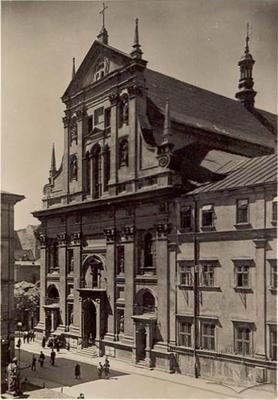 Костел єзуїтів та площа Трибунальська (тепер пл. Яворського)
Костел єзуїтів та площа Трибунальська (тепер пл. Яворського)
-
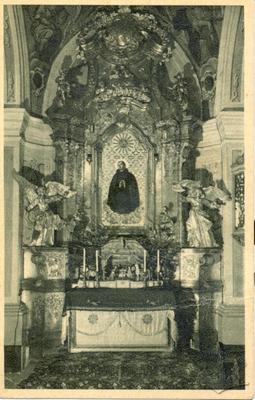 Вівтар Св. Станіслава Костки в костелі єзуїтів
Вівтар Св. Станіслава Костки в костелі єзуїтів
-
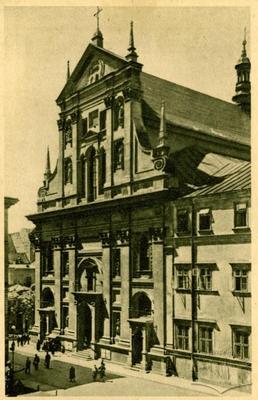 Костел Святих Апостолів Петра і Павла
Костел Святих Апостолів Петра і Павла
-
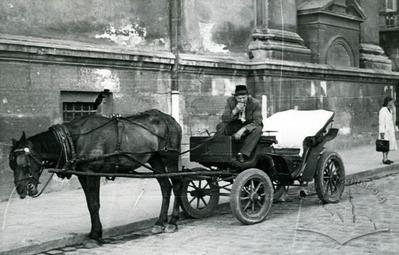 Фаетон на пл. Івана Підкови
Фаетон на пл. Івана Підкови
-
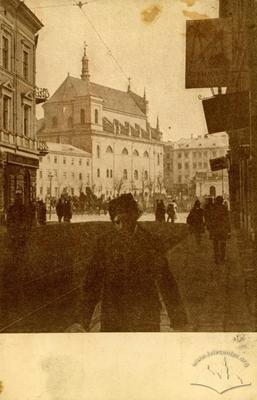 Вид на костел єзуїтів з вулиці Сикстуської (тепер вул. Дорошенка)
Вид на костел єзуїтів з вулиці Сикстуської (тепер вул. Дорошенка)
-
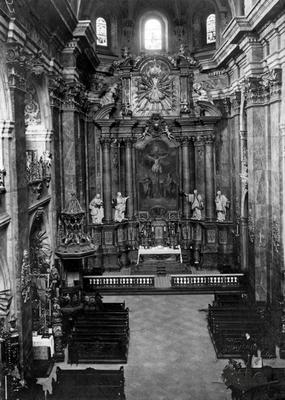 Інтер'єр костелу єзуїтів
Інтер'єр костелу єзуїтів
-
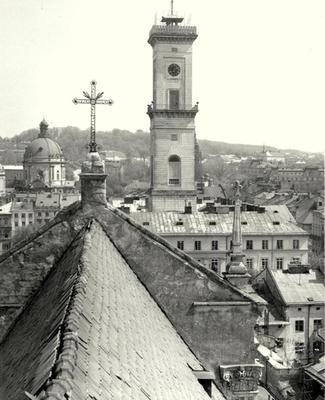 Вид на східну частину міста з вежі костелу Єзуїтів
Вид на східну частину міста з вежі костелу Єзуїтів
-
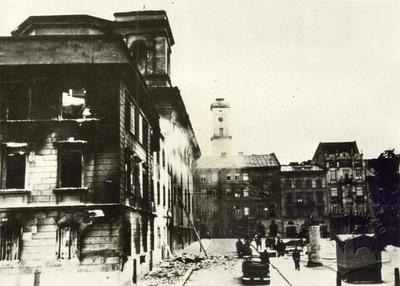 Площа Св. Духа.
Площа Св. Духа.
-
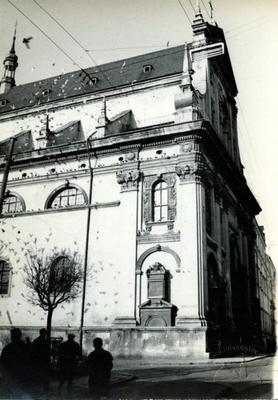 Костел Св. Петра і Павла ордену єзуїтів з боку вулиці Театральної
Костел Св. Петра і Павла ордену єзуїтів з боку вулиці Театральної
-
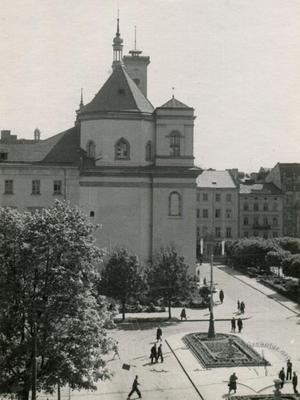 Фрагмент вул. 1 Травня та площі Івана Підкови
Фрагмент вул. 1 Травня та площі Івана Підкови
-
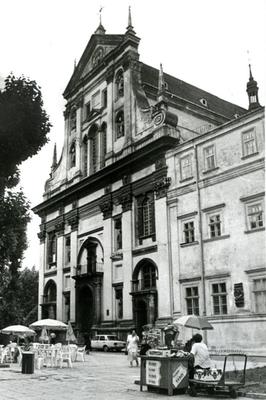 Площа ім. Народної гвардії ім. І. Франка, тепер пл. С. Яворського
Площа ім. Народної гвардії ім. І. Франка, тепер пл. С. Яворського
-
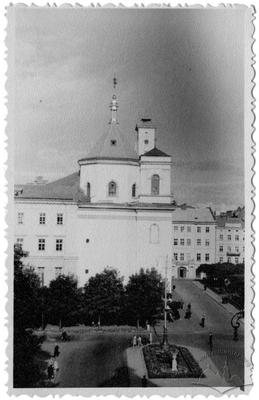 Вид на вул. 1 Травня (тепер пр. Свободи) та костел єзуїтів
Вид на вул. 1 Травня (тепер пр. Свободи) та костел єзуїтів
-
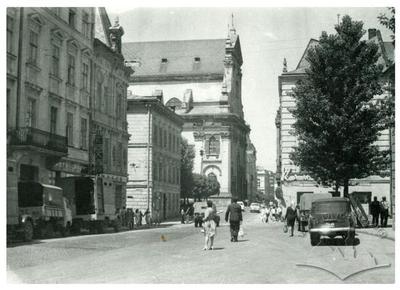 Вид вулиці Театральної
Вид вулиці Театральної


















